Ganesha Chaturthi is one of the foremost festivals that celebrate Ganesha year after year in India. The communal festival lasts for ten days and ends with the Ganesha Visarjan where the Lord is bid farewell by immersing his idols in water. This festival has lent itself to the development of a new culture- Ganesha culture! There are many agencies that are involved in the preparation of this festival and also the participation levels are huge both in terms of personal worship as well as communal worship.
Started by freedom fighter Lokmanya Bal Gangadhar Tilak in 1894 with a small idol, the festival today has transformed into a major social festival and tourist attraction centred around the community worship of Ganesha, the lovable, pot-bellied, four-armed god who is said to remove all obstacles from people's path and bring them luck.
Popularised by Lokmanya Tilak, Ganesha Chaturthi got reinvented from a festival celebrated in the privacy of one’s home to a “Sarvajanik Utsav” – a communal festival. Tilak’s noble intention was to utilize the deity’s acceptance by all ethnic communities and unite people against the colonial oppressors- the British Raj in those times. Ever since there’s been no looking back and the festival has grown in scale and Ganesha has outgrown his primary, religious avatar and has become an omnipresent cultural icon.
Over the years one has seen the rise in innumerable Ganesha Mandals that organize massive public celebrations for ten days. They compete fiercely to introduce variety and a sense of the contemporary into their displays and the Ganesha statues installed. Usually, alongside the traditionally decorated idol, it’s not unusual to find themes selected from currently popular or significant happenings in our country. He could be seated on a throne
or a mouse - his mount. He could be standing, with two hands, or four could be flanked with lions or whatever fanciful way in which the idol makers want to depict him. Thus artistic exploration plays a large role along with the traditional festivities.
This festival is a platform which transforms Ganesha from his traditional base in religion and mythology into a supremely adaptable, evolving deity. Ganesha thus connects equally with his devotees at both the personal and community levels at all times.
When is Ganesh Chaturthi celebrated?
It is celebrated on the fourth day after the new moon in the Hindu month of Bhadrapada. This can occur anytime between late August and early September, depending on the cycle of the moon. It is celebrated for 10 days, with the biggest spectacle taking place on the last day called Ananta Chaturdasi.
Where is Ganesh Chaturthi celebrated?
Though the festival is very popular in the states of Maharashtra, Goa, Tamil Nadu, Karnataka and Andhra Pradesh, one of the best places to experience the festival is in the city of Mumbai. Celebrations take place in many homes, temples, and Mandals. In Siddhivinayak temple, dedicated to Lord Ganesha, located in the central suburb of Prabhadevi in Mumbai, an incalculable number of devotees visit the temple to pray and pay their respects to God during the festival. In addition, around 10,000 statues of Lord Ganesha are displayed at various Mandals in various locations in the city.
What rituals are performed during Ganesh Chaturthi?
Once an idol of Ganesha is installed, a ceremony is undertaken to invoke his holy presence. This ritual is called the Pranapratishhtha Puja, during which a number of mantras are recited. Following this, special worship is performed. Offerings of Modaks, sweets, flowers, rice, coconut, and jaggery are made to God. The idol is also anointed with red Chandan powder. Prayers are offered to Lord Ganesha every day during the festival. Aarti is performed every day in the morning and evening amidst the chanting and singing of Bhajans. Temples devoted to Lord Ganesha also organize special events and prayers. Those
who have a Ganesha idol in their house treat and care for him as a much-loved guest.
How is Ganesh Chaturthi celebrated?
The festival begins with the installation of a Ganesha idol in homes and Mandals which have been specially constructed and beautifully decorated. This is the result of months of effort put in by various artisans. After the pujas and celebrations for the 10 days, on the last day - Ananta Chaturdasi, the idols are taken in a procession through the streets, accompanied by singing, dancing, loud music and fervour only to be immersed in the ocean or other water bodies. The festival is celebrated in a very public manner. Local communities compete with each other to put up the biggest and best Ganesha idol and display it. In Mumbai alone, more than 150,000 statues are immersed each year!
Why are the Ganesh idols immersed in water at the end of the festival?
Hindus worship idols of their gods because it gives them a visible form to pray to. Ganesha idols made during the festival are made of clay or plaster of Paris, materials that can disintegrate in water, and are temporary. This indicates that the deity is created for some time, exists for some time, and is destroyed eventually, only to return the next time it is time to worship him. This practice draws attention to the cyclical nature of life. Form eventually gives way to formlessness. Nothing is static in this universe. Everything changes, seasons come and go, the moon waxes and wanes, and fortunes and the quality of relationships undergo a change. Ganesha worship draws attention to this ever-changing ever repeating nature of life. However, the energy still remains. The festival ends with the immersion of the idols in the ocean, or other bodies of water, and their subsequent destruction each year serves as a reminder of this belief.
Ganesh Chaturthi at home
Though Ganeshotsav has gained immense popularity as a community festival, it is also a very popular and important festival that is celebrated at home by many families across Maharashtra, Andhra Pradesh, Karnataka and Tamil Nadu.
It is a family tradition to celebrate the Ganesha festival year after year in many homes. Many believe that they and their families, homes, occupations, and businesses get blessed if they bring home a Ganesha idol and perform the puja. Thus the families look forward to it, by planning the type of idol to buy, the theme for the decorations that surround the idol, the celebrations etc.
The Giani family in Mumbai too hold this belief strongly in their heart and they celebrate Ganesha Chaturthi with a lot of devotion. They have been celebrating this festival since 1990 in their home and have kept it up till date. They usually keep the Ganesha idol for one and a half days in their home.
They plan months in advance to decide on a theme for each year’s Ganesha idol and the decorations that go with it. The whole family participates, from placing the order for a particular type of idol, to purchasing, creating decorations and executing the theme in the best possible way in their drawing room. Sometimes even close friends and neighbours participate in this process.
The themes that they have chosen usually depend on the type and size of the Ganesha idol that they have ordered. The Ganesha idol is usually placed on a large table against a large wall in their drawing room. The wall behind the idol is where the theme-based decorations are created like a large backdrop. The table too gets covered according to the theme. They have created fabric fans in the background, created mirror work on the wall similar to that found in Kutchi villages, used terracotta elephants with decorated terracotta pots on both sides of the Idol, created gold-coloured trees on the background wall, created large gold frame on the wall, created huge peacock feather designs using coloured stones and sequins, created colourful backdrops using flowers by professional florists, used peacock feathers to create an interesting backdrop amongst the many themes that they have explored over the years. Rich fabrics like satin, gold tissue, and silk, in multiple hues and colours have been used to lend a new look each year.
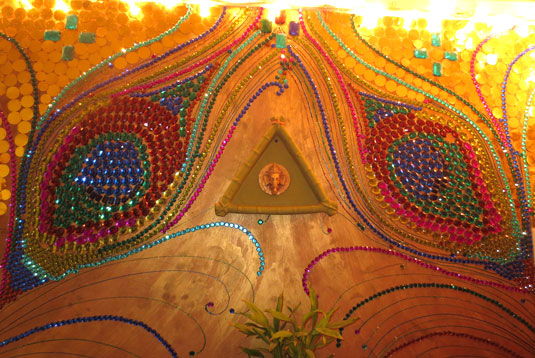
A backdrop was created (to look like peacock feathers ) for the Ganesha idol before Ganesh Chaturthi.

A backdrop was created on the wall only with colourful flowers and greens for the festive Ganesha idol.
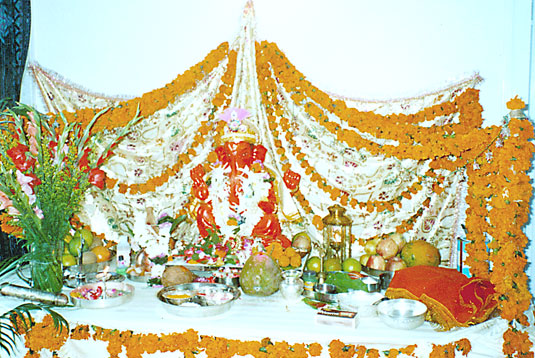
Marigold floral garlands and a large swathe of fabric are used to create a backdrop for the festive Ganesha idol.
Along with the special decorations, special lighting arrangements too are also made around the Ganesha idol. Usually, halogen lamps or strings of tiny LED lamps are placed at strategic points to enhance the theme and create a truly festive atmosphere.
After the “Sthapana” or the installation of the Idol, the main Ganesha puja is performed. Aarti performed again in the evening, the next morning and before setting out with the Ganesha idol for Visarjan. Prasad in the form of sweets or fruits is offered to the Lord.
Many relatives, friends, and neighbours, visit their homes on these one-and-half days and participate in the puja, aartis willingly. They are welcomed with open arms by the Giani family. All the guests are offered either meals, or snacks based on the time of their visits wholeheartedly and a generally festive atmosphere permeates the Giani household during the Ganesh Chaturthi.
The Giani family looks forward to this form of celebration and has many wonderful experiences during these one and half days. It is the firm belief of Mrs. Dhuru Giani that she faces no problems at all in the arrangements that need to be made, the quantity of food that is required, the extra help in terms of servants, and cooks that come in during the Ganesha Chaturthi celebrations. She believes that their faith in performing the Lord Ganesha’s puja sincerely ensures the blessings of the Lord in all that they do and to each person in their family and also to each visitor who comes to have darshan. She and many of her friends have had several personal experiences, especially during the Ganesha festival days in their home which make the Giani family believe that the benevolent Lord Ganesha truly protects and helps his devotees always.
Another thing that the Giani family also believes is in the concept of recycling. After the Visarjan, most of the decorations in the fabric form are reused, by converting them into personal garments. Other decorations are passed on to friend/s who willingly reuse them in their homes for the following year’s Ganesha puja. Thus they ensure that nothing goes to waste despite elaborate decorations.
The principle of recycling is also followed with all the sweets, and fruits that the visitors offer to their Ganesha. These are distributed the very next day to an orphanage close by, so nothing gets wasted.
As part of prasad or a return gift to the visitors/ devotees who come to their home, the Giani family gives a small Ganesha idol, or a Ganesha-related gift article each year.
The Giani family also has a large collection of Ganesha idols in various sizes. These have been collected over many years. Many are gifts as people give them Ganesha idols and Ganesha-related articles as they are aware of their fondness for the Lord. Some have been bought by them. These are displayed in their drawing room on a permanent basis.
The following images capture a few Ganesha idols from their collection.
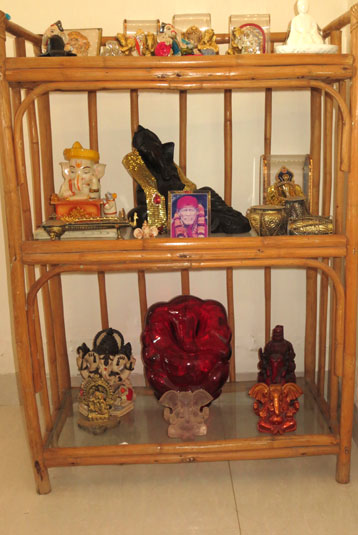
Different idols of Ganesha in various shapes, sizes and materials are arranged on a cane shelf.
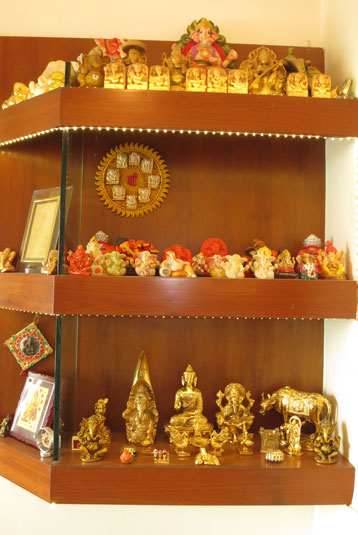
Some more Ganesha idols are arranged on a wall-mounted vertical wooden shelf.
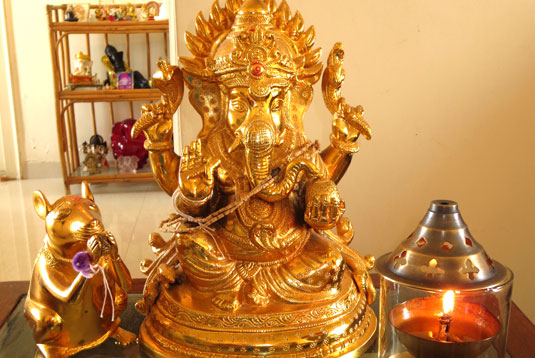
A view of a large, beautifully crafted golden Ganesha idol placed on a side table in the drawing room along with the Ganesha idol collection on the shelves in the background.
A few close-up views of some of the Ganesha idols from their collection.
Thus the above example of the Ganesha Chaturthi celebrations and collection of Ganesha idols of the Gianni family is a small indication of the vast influence the Lord Ganesha has in people’s lives.









